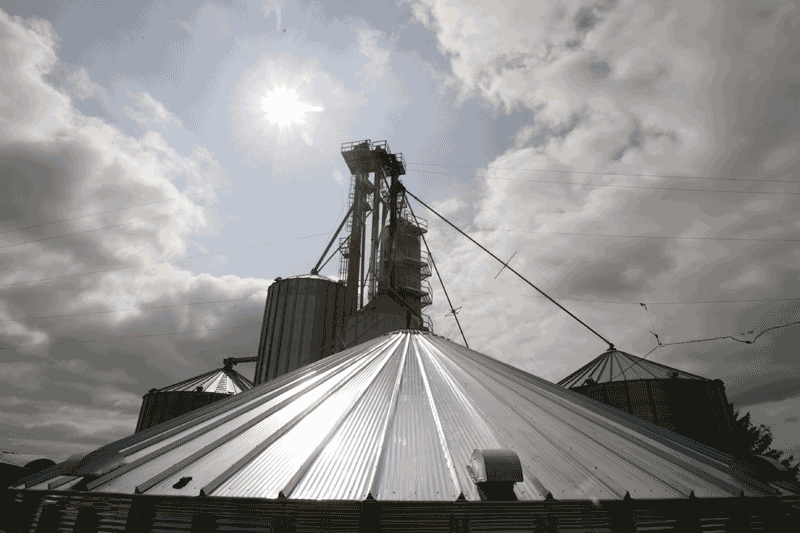Energy efficient grain drying
TIPS FOR GETTING THE BEST GRAIN DRYER FOR YOUR DOLLAR
canada’s grain trade is evolving, affected not only by the end of single-desk sales but by changes in grain production such as last year’s record corn crop – and these changes may prompt some farmers to consider investing in grain drying and on-farm storage to increase their grain marketing alternatives.

The American experience with farm-based grain storage can offer some useful pointers for anyone exploring this investment. Mark Hanna, an agricultural engineer and expert on farm energy use at Iowa State University (ISU), suggests taking a hard look at the energy issues involved in grain drying systems.
“The best choices may be different for different sized operations,” Hanna says, noting that energy bills for corn drying can rival the costs for fuel to plant and harvest the crop in some years.
consider your hybrid
“If you’re looking at increased corn production, the first alternative may not be obvious,” he suggests. “Consider which hybrids you are planting. Maybe a shorter-season hybrid will give you better dry-down in the field and reduce the need for a drying system investment.”
In yield trials at Ames, Iowa, researchers have found little difference between full-season and short-season hybrids – a result that may apply to some Canadian corn producers, since Ames and southwestern Ontario are on the same latitude.
In some cases, natural-air or low-temperature drying systems can be a highly efficient method. Low-temperature systems take advantage of the natural drying potential of warm autumn air, using a larger fan to pull air through stored grain without the need to invest in extra drying equipment or in the gas to run it.
Drying is slower in low-temperature systems, however, and is not suited to larger bins because of airflow requirements. It is best suited for bins with less than 18 feet of grain depth.
Another energy efficient approach to help increase drying capacity uses dryeration or combination drying. This method calls for initial drying in a high-temperature dryer. Then high-temperature drying is halted at a moisture level higher than the final target moisture. That is followed by a delayed cooling process of four to 12 hours (dryeration) in a separate bin, which allows moisture levels to equalize within the corn kernels. Further cooling after this resting period can remove an extra 0.2 to 0.25 points of moisture for each 10 degrees of temperature change.
By requiring less time in the high-temperature dryer, dryeration can increase drying capacity by 50 to 70% and increase drying efficiency by 15 to 30%.
consider your operation
For those prepared to invest in a new drying system, much of the emphasis in drying technology is on continuous flow dryers, but Hanna says the best energy choice for some farms may still be a bin dryer.
“It depends on the size of the operation. Farmers with 1,500 to 2,000 acres have gone to the continuous flow dryers, but farms with 1,000 acres or less may still be okay with bin dryers,” he says.
He urges growers to think about drying capacity not just in terms of handling more bushels per hour. “Efficiency can also mean getting the most water out of the grain for the least energy, and that may mean looking at all your system choices, including bin dryers.”
“If you’re in the market for equipment, ask to see data on the number of BTUs (British thermal units) of energy it will take to remove a pound of water,” he suggests. “For older conventional, high-temperature, continuous flow dryers, that can be 2,800 to 3,000 BTU per pound, but manufacturers are trying to get closer to 2,000 BTU. So ask the seller what the claim is. It will give you something to compare, even though we don’t have third-party testing to verify claims.
“If they claim closer to 2,000 BTU per pound and especially if they claim less than 2,000 BTU, ask more questions about how they are achieving that.”
Another factor to check is the energy efficiency of dryer fans, which has improved with the move from the vane axial fans, common ten years ago, to newer, more efficient centrifugal fans.
For details on energy use alternatives in corn drying and storage, see ISU’s Farm Energy Initiative website at: http://farmenergy.exnet .iastate.edu/.
Click on “Farm Energy Publications” to find fact sheets on corn drying efficiency, low-temperature grain drying, dryeration and combination drying, and managing high temperature grain dryers. •






















